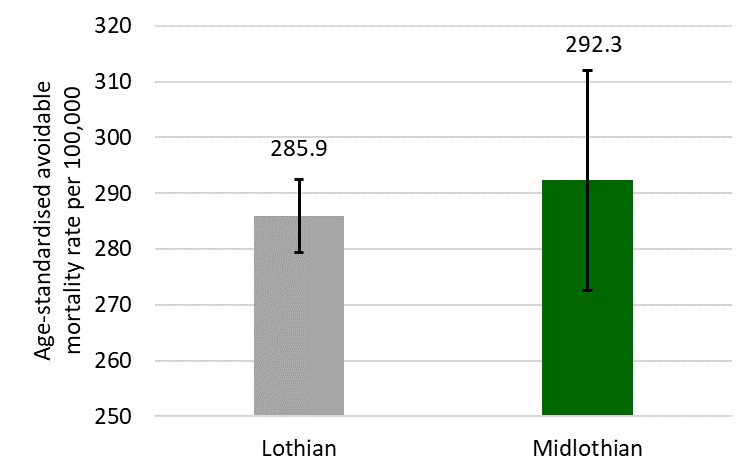Life Expectancy - Data
Life Expectancy is an estimate of the number of years a new-born child would live if it were to experience the current mortality rate for all its life. It is a measure of the overall health of a population and how well society is doing.
Life expectancy increased steadily in both Midlothian and Scotland from 2001-2003 until 2011-13, when it began to stall. Life expectancy in Midlothian is above the Scottish average.
- Sex - women’s life expectancy (80.94 years) is higher than men’s life expectancy (77.06 years) in Midlothian in 2020-2022. In Midlothian, females have life expectancy at birth almost 4 years higher than Midlothian males. Male life expectancy in Midlothian is 1 year above the national average, while Midlothian female’s life expectancy is almost a year higher than the national average.
- Inequality - life expectancy varies by up to 10 years across different parts of Midlothian (National Records Scotland,2023).
Healthy life expectancy
Healthy life expectancy is the average number of years that a new-born can expect to live in “full health.”
- Sex - between 2017-19 and 2018-20 Midlothian males’ healthy life expectancy dropped by more than 5 years from 63.97 to 58.59. This is likely due to the covid pandemic. For the same period Midlothian females’ health life expectancy fell 0.3 years. The national averages appear to have been more stable during this period as well with a fall in healthy life expectancy 0.75 years for males and 0.15 years for females.
Mortality
It is important to monitor the number of deaths (mortality) observed in an area over a specified time. These are best compared as rates per 100,000 population, age-standardised to take account of differences in the structure of the population so that we are comparing like with like. For instance, one area might have a lower death rate than another simply because the proportion of younger people living there is higher than the second area. Age-standardisation takes account of these differences between areas.
We expect to see a relationship between the relative socioeconomic deprivation of an area and the mortality rate, with the most deprived areas having the highest mortality rate. This relationship is found in Midlothian.
Early deaths (premature mortality)
If someone dies aged less than 75 years this is considered to be an early or premature death and potentially preventable. Early mortality rates are the number of deaths of people under 75 observed over a specified time. These are a subset of the overall death rate. These are best compared as rates per 100,000 population, standardised to take account of differences in the structure of the populations being compared.
Avoidable mortality
Avoidable Mortality is deaths under the age of 75 which are considered either preventable or treatable through public health interventions or timely and effective healthcare. This is a subset of early mortality and is based on an international definition by the OECD/Eurostat (National Records Scotland, 2023). Midlothian has the second highest avoidable mortality rate in the Lothians, with West Lothian being the highest and East Lothian being the lowest.
Avoidable mortality rates, all persons 2019-2021 Average
Data source: National Records Scotland

Page updated: February 2025
